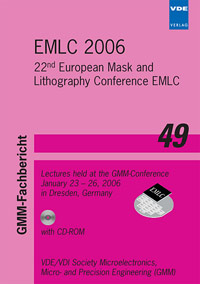A Correlation for Predicting Film Pulling Velocity in Immersion Lithography
Konferenz: EMLC 2006 - 22nd European Mask and Lithography Conference
23.01.2006 - 26.01.2006 in Dresden, Germany
Tagungsband: EMLC 2006
Seiten: 9Sprache: EnglischTyp: PDF
Persönliche VDE-Mitglieder erhalten auf diesen Artikel 10% Rabatt
Autoren:
Schuetter, Scott; Shedd, Timothy; Doxtator, Keith; Nellis, Gregory (University of Wisconsin, United States)
Peski, Chris Van (SEMATECH, United States)
Inhalt:
Immersion lithography seeks to extend the resolution of optical lithography by filling the gap between the final optical element and the wafer with a liquid characterized by a high index of refraction. There are several engineering obstacles associated with the insertion of the immersion fluid. One issue that has recently been identified is the deposition of the immersion liquid onto the wafer from the receding contact line during the scanning process; any residual liquid left on the wafer represents a potential source of defects. The process of residual liquid deposition is strongly dependent on the behavior of the receding three-phase contact line and this paper focuses on an experimental investigation of this behavior under conditions that are relevant to immersion lithography. Specifically, the static and dynamic contact angle and the critical velocity for liquid deposition are presented together with a semi-empirical correlation developed from these measurements. The correlation allows the film pulling velocity to be predicted for a given resist-coated surface using only a measurement of the static receding contact angle and knowledge of the fluid properties. This correlation represents a useful tool that can be used to approximately guide the development of resists for immersion systems as well as to evaluate alternative immersion fluid candidates in order to minimize film pulling and defects while maximizing throughput.


